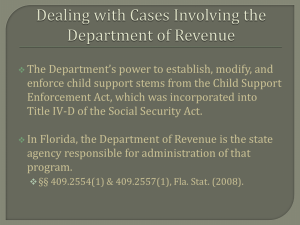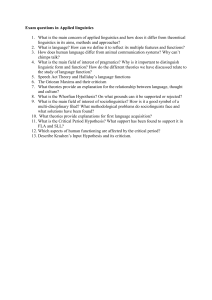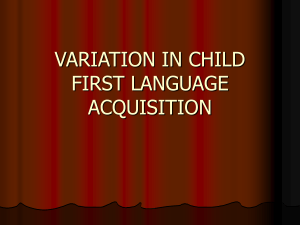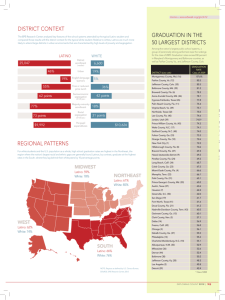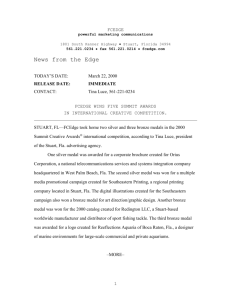Reply to Response to Writ of Habeas Corpus
advertisement
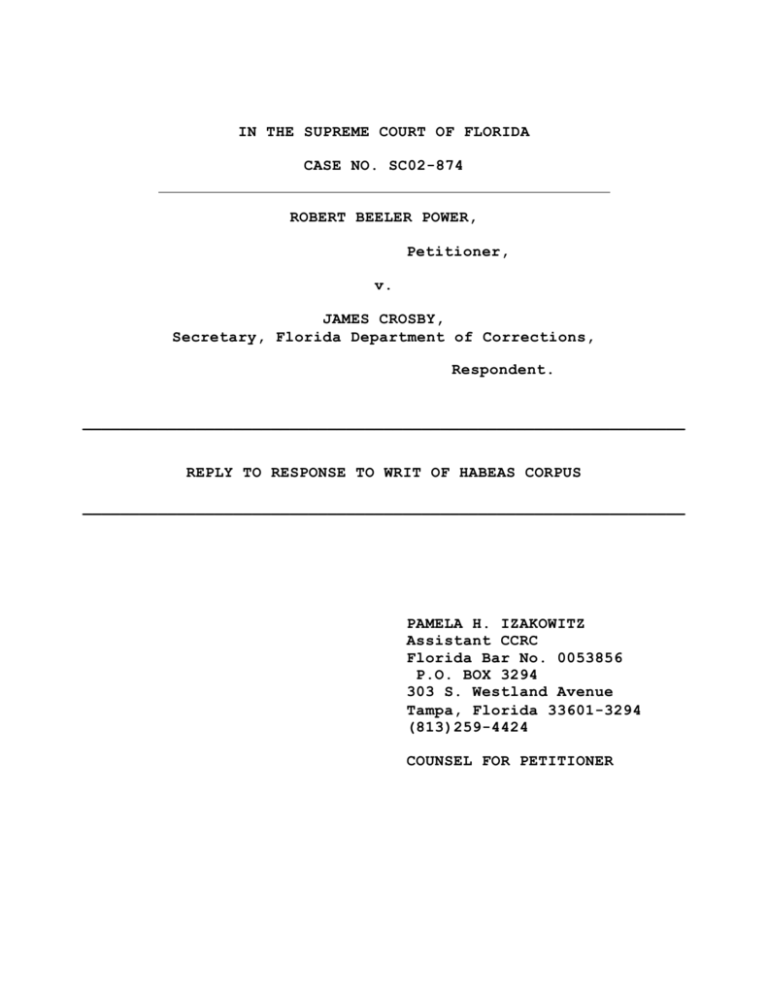
IN THE SUPREME COURT OF FLORIDA CASE NO. SC02-874 ROBERT BEELER POWER, Petitioner, v. JAMES CROSBY, Secretary, Florida Department of Corrections, Respondent. ________________________________________________________________ REPLY TO RESPONSE TO WRIT OF HABEAS CORPUS ________________________________________________________________ PAMELA H. IZAKOWITZ Assistant CCRC Florida Bar No. 0053856 P.O. BOX 3294 303 S. Westland Avenue Tampa, Florida 33601-3294 (813)259-4424 COUNSEL FOR PETITIONER ARGUMENT IN REPLY ARGUMENT III FLORIDA’S CAPITAL SENTENCING STATUTE VIOLATES THE SIXTH AND FOURTEENTH AMENDMENTS The State argues that Mr. Power’s reliance on Ring v. Arizona, 122 S. Ct. 2428 (2002) “has no application to cases not on direct review.” (Response at 12). The State’s argument should be rejected. The State fails to mention that this Court has repeatedly addressed the merits of claims under Ring or Apprendi v. New Jersey, 530 U.S. 466 (2000), without mentioning whether or not the claim was raised at trial or on direct appeal. This is true whether the claim was presented on direct appeal1, in 1 See Lawrence v. State, 2003 WL 1339010 at *8 (Fla. Mar. 20, 2003); Lugo v. State, 2003 WL 359291 at *28 n.79 (Fla. Feb. 20, 2003); Kormondy v. State, 2003 WL 297027 at *10 (Fla. Feb. 13, 2003); Anderson v. State, 841 So. 2d 390, 408-09 (Fla. 2003); Cox v. State, 819 So. 2d 705, 724-25 (Fla. 2002); Hurst v. State, 819 So. 2d 689, 702-03 (Fla. 2002). 2 post-conviction,2 or even in a motion for rehearing3 or notice of supplemental authority.4 Mr. Power’s claim is before the Court on the merits. The State also argues that Ring does not apply retroactively (Response at 13). Florida courts decide questions of retroactivity under Florida’s standards. State, 387 So. 2d at 928. Witt v. See also House v. State, 696 So. 2d 515, 518 n.8 (Fla. 4th DCA 1997); Gantorius v. State, 693 So. 2d 1040, 1042 n.2 (Fla. 3d DCA 1997), approved in State v. Gantorius, 708 So. 2d 276 (Fla. 1998). In Witt v. State, 387 So. 2d 922 (Fla. 1980), this Court explained that the doctrine of finality must give way when 2 See Jones v. State, 2003 WL 21025816 at *5 (Fla. May 8, 2003); Chandler v. State, 2003 WL 1883682 at n.4 (Fla. Apr. 17, 2003); Banks v. State, 2003 WL 1339041 at *4 (Fla. Mar. 20, 2003); Jones v. State, 2003 WL 297074 at *9 (Fla. Feb. 13, 2003); Spencer v. State, 842 So. 2d 52, 72 (Fla. 2003); Lucas v. State, 841 So. 2d 380, 389 (Fla. 2003); Porter v. Crosby, 840 So. 2d 981, 986 (Fla. 2003); Fotopoulos v. State, 838 So. 2d 1122, 1136 (Fla. 2002); Bruno v. Moore, 838 So. 2d 485, 492 (Fla. 2002); King v. Moore, 831 So. 2d 143 (Fla. 2002); Bottoson v. Moore, 833 So. 2d 693 (Fla. 2002); Sweet v. Moore, 822 So. 2d 1269, 1275 (Fla. 2002); Sireci v. Moore, 825 So. 2d 882, 888 (Fla. 2002); Mills v. Moore, 786 So. 2d 532 (Fla. 2001). 3 See Butler v. State, 2003 WL 1786712 (Fla. Apr. 3, 2003); Grim v. State, 841 So. 2d 455, 465 (Fla. 2003); Doorbal v. State, 837 So. 2d 940, 963 (Fla. 2003); Chavez v. State, 832 So. 2d 730, 767 (Fla. 2002). 4 See Marquard v. State, 2002 WL 31600017 at *10 n.12 (Fla. Nov. 21, 2002). 3 fairness requires retroactive application: The doctrine of finality should be abridged only when a more compelling objective appears, such as ensuring fairness and uniformity in individual adjudications. Thus, society recognizes that a sweeping change of law can so drastically alter the substantive or procedural underpinnings of a final conviction and sentence that the machinery of postconviction relief is necessary to avoid individual instances of obvious injustice. Considerations of fairness and uniformity make it very “difficult to justify depriving a person of his liberty or his life, under process no longer considered acceptable and no longer applied to indistinguishable cases.” Witt, 387 So. 2d at 925 (footnote omitted). reaffirmed the Witt fairness test. This Court has State v. Callaway, 658 So. 2d 983, 987 (Fla. 1995). This fairness test is in keeping with the United States Supreme Court’s interpretation of the test in Stovall v. Denno 388 U.S. 293 (1967). The Court has said that the first prong of this test--the purpose to be served by the new rule--is the most important prong: [O]ur decisions establish that “[f]oremost among these factors is the purpose to be served by the new constitutional rule,” Desist v. United States, 394 U.S. 244, 249 . . . (1969), and that we will give controlling significance to the measure of reliance and the impact on the administration of justice “only when the purpose of the rule in question [does] not clearly favor either retroactivity or prospectivity.” Id., at 251. . . . [citations omitted]. “Where the major purpose of new constitutional doctrine is to overcome an aspect of the criminal trial that substantially impairs its truth-finding function and so raises serious 4 questions about the accuracy of guilty verdicts in past trials, the new rule has been given complete retroactive effect. Neither good-faith reliance by state or federal authorities on prior constitutional law or accepted practice, nor severe impact on the administration of justice has sufficed to require prospective application in these circumstances.” Williams v. United States, 401 U.S. 646, 653 . . . (1971) (plurality opinion of WHITE, J.). Brown v. Louisiana, 447 U.S. 323, 328 (1980) (plurality opinion). “The right to jury trial guaranteed by the Sixth and Fourteenth Amendments ‘is a fundamental right, essential for preventing miscarriages of justice and for assuring that fair trials are provided for all defendants.’” Id. at 330, quoting Duncan v. Louisiana, 391 U.S. 145, 158 (1968). This right is so fundamental that its deprivation constitutes a structural defect in a trial. Sullivan v. Louisiana, 508 U.S. 275, 281 (1993). The rule of Ring is the kind of “sweeping change of law” described in Witt. In Apprendi, Justice O’Connor’s dissenting opinion described the rule of that case as “a watershed change in constitutional law.” Apprendi, 120 S. Ct. at 2380 (O’Connor, J., dissenting). Extending Apprendi’s rule to capital cases, as the Supreme Court did in Ring, is no less of a “watershed change.” In this Court, Chief Justice Anstead has said that Ring “is clearly the most significant death penalty decision of the 5 U.S. Supreme Court since the decision in Furman v. Georgia,” Bottoson v. Moore, 833 So. 2d 693, 703 (Fla. 2002) (Anstead, C.J., concurring in result only), and Justice Pariente has described Ring as a “landmark case.” Bottoson v. Moore, 824 So. 2d 115, 116 (Fla. 2002) (Pariente, J., concurring). Justice Shaw concluded that Ring applies retroactively under Witt and meets the test of Stovall v. Denno for retroactive application. Bottoson, 833 So. 2d at 717 & n.49 (Shaw, J., concurring in result only). The United States Supreme Court has explained that under a Stovall v. Denno analysis, “resolution of the question of retroactivity does not automatically turn on the particular provision of the Constitution on which the new prescription is based.” Brown, 447 U.S. at 327. Rather, under a Stovall v. Denno analysis, the retroactivity decision must be done on a case-by-case basis, looking at the particulars of the rule in question. Brown, 447 U.S. at 334 n.13. The purpose of the rule in Ring is to change the very identity of the decision maker with respect to critical issues of fact that are decisive of life or death. This change remedies a “‘structural defect[] in the constitution of the trial mechanism,’” by vindicating “the jury guarantee . . . [as] a ‘basic protectio[n]’ whose precise effects are 6 unmeasurable, but without which a criminal trial cannot reliably serve its function.” at 281. Sullivan v. Louisiana, 508 U.S. Florida has provided for a jury’s participation at capital sentencing and gives significance to the jury’s decision, but has not applied Sixth Amendment requirements to the jury’s participation. Thus, under a Stovall v. Denno analysis, Ring’s retroactivity is clear. Brown, 447 U.S. at 334 n.13 (the decision in DeStefano v. Woods “does not necessarily mean that a constitutional rule directed toward ensuring the proper functioning of the jury in those cases in which it has been provided must also be given only prospective effect”) (emphasis in original). Finally, the rule of Ring applies to capital cases and therefore its retroactivity must take into account that “the penalty of death is qualitatively different from a sentence of imprisonment.” Woodson, 428 U.S. at 305. The State does not discuss the arguments presented in Mr. Power’s petition regarding the structure of Florida’s capital sentencing scheme or the errors in Mr. Power’s case (Petition for habeas corps at 18-28). Mr. Power relies on those arguments. CONCLUSION For the remaining issues, Mr. Power relies on his petition for 7 writ of habeas corpus and urges this Court to grant habeas corpus relief. 8 CERTIFICATE OF SERVICE I HEREBY CERTIFY that a true copy of the foregoing Reply to Response to Petition for Writ of Habeas Corpus has been furnished by United States Mail, first class postage prepaid, to Douglas T. Squire, Assistant Attorney General, 444 Seabreeze Boulevard, 5th Floor, Daytona Beach, Florida 33118, on June 9, 2003. ______________________________ Pamela H. Izakowitz Assistant CCRC Florida Bar No. 0053856 P.O. Box 3294 303 S. Westland Ave., Tampa, Florida 33601-3294 (813)259-4424 Attorney for Petitioner 9 CERTIFICATE OF COMPLIANCE The undersigned counsel hereby certifies that this petition complies with the font requirements of Fla. R. App. P. 9.100(l) and 9.210(a)(2). ______________________________ Pamela H. Izakowitz Assistant CCRC Florida Bar No. 0053856 Attorney for Petitioner 10
